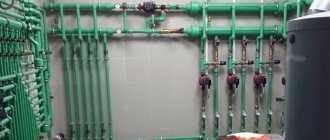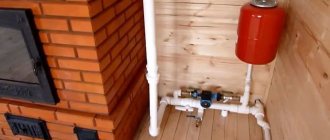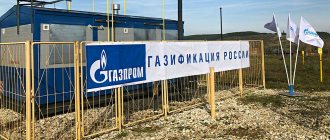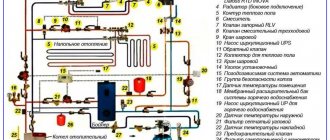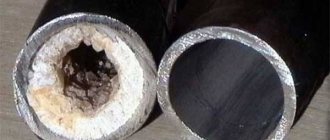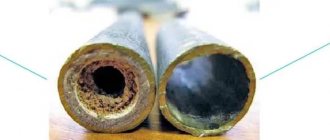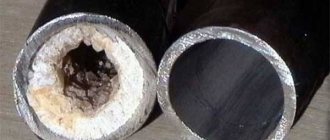The choice of heating method depends on the financial capabilities of the homeowner. Citizens with above-average incomes are more interested in modern heating systems and the latest energy-saving equipment. Rural residents with low incomes set the task differently: to economically heat an apartment or private house, incurring minimal installation costs.
Both groups of homeowners are united by a completely understandable desire - to pay less for utilities. There are also two options for solving the problem: use new technologies or quit/reduce consumption of expensive energy resources.
We distinguish between central and autonomous
Central heating
| Central heating |
This is a system in which a thermal power plant or boiler house is the source of heat and runs on fuel. It is located in a separate building. Heat is sent through pipes to apartments and released by heating devices - radiators. The coolant comes in the form of water, steam, air.
Water heating - water circulates in pipes. It is heated in the boiler room and brings the heat of the fuel through the pipes to the radiators. Radiators release thermal energy into the room. In winter, the surface of the radiators heats up to 60-70 degrees. In cold weather they are heated to 80 degrees.
Networks are designed as one-pipe, two-pipe, multi-pipe. In cities, networks are organized according to the two-pipe principle. Through the second pipe, the cooled “return” water returns to the boiler. This is how the entire system circulates, heat goes from the boiler room to the residents of the houses. Heating with water meets sanitary and hygienic standards, so it is most often used in residential buildings, schools, kindergartens and hospitals.
With the air heating option, hot air moves through the pipes and transfers heat to the room. For heating, central air heaters or air heaters are used. Such a system, like water heating, does not harm health due to its hygiene.
Steam heating is prohibited for use in residential buildings. The coolant is steam, the heat source is a steam boiler. Disadvantages of this type of heating: it is impossible to regulate the temperature smoothness, it is noisy, the surfaces of heating devices get very hot.
Pros and cons of central heating
| City services monitor the equipment; | The serviceability of city equipment depends on the wear and tear and conscientiousness of housing office employees; |
| They also repair and maintain the system, but this also creates disadvantages. | It is impossible to regulate the heating temperature - it is the same in all rooms, and this is not always comfortable; |
| The pressure in the system sometimes jumps, this leads to accidents; | |
| Large losses at the heat delivery stage: every kilometer 1 degree is lost; | |
| The timing of seasonal shutdowns is not controlled by residents. |
Heating system
| Liquefied gas in cylinders |
Autonomous means independent. Autonomous heating has many advantages. It does not depend on central systems. The boiler is located directly at home, and you control the heating yourself. Residents do not overpay monthly due to the remoteness of the heat source, and do not suffer from pipe wear. Organizing autonomous heating is expensive, but it quickly pays for itself. There is gas, electric, and a stove or fireplace.
1. Gas heating. Gas is the cheapest fuel in Russia, so gas heating is popular among owners of private houses. The principle of the device is simple - you need a boiler, a water system and batteries as heating devices. We supply gas to the boiler and start the system. It is important not to confuse liquefied and main gas. If you heat with imported cylinders, it is 5 times more expensive than electric heating.
An autonomous gas system is a treasure not only for a home, but also for an apartment. When comparing two equal areas, in an apartment with autonomous gas heating, utility bills are 1.5-2 times less than with central heating.
Pros and cons of gas heating:
| Gas is a cheap fuel; | It is impossible to repair without a specialist; |
| There is no dependence on the central system; | Repair costs; |
| Can be used in combination with alternative heat sources. For example, make a warm floor. | You will have to personally monitor the operation of the boiler and system. |
2. Electric heating. Gas is not available everywhere. Therefore, people have to choose alternative heat sources. Electricity is pure energy. The cheapest equipment, but not very economical to use. Compared to liquid coolants, electrical energy is converted into heat without loss. Therefore, electric heating has the highest efficiency. Efficiency is the amount of heat per unit of resource/fuel used.
Pros and cons of electric heating:
| Many solutions: radiators, convectors, heated floors, walls and baseboards; | You need a powerful, working network and wiring; |
| Saving on water supply to the house; | You are dependent on electricity; |
| There is no need to purchase fuel and worry about storing it; | Expensive resource. |
| Compact equipment; | |
| Leaks are excluded; | |
| Safely; | |
| Eco-friendly; | |
| There is no dependence on the central system. |
Electric heating is distinguished by heat source. Let's look at the most popular ones.
Electric boilers provide water heating: the boiler heats the coolant - water. Cold water becomes hot and circulates through the pipes, permeating the house. Electrical energy is converted into heat. This system is chosen when there is no supplied gas.
| Autonomous heating, electric boiler |
Boilers come in different shapes and modifications. The main thing in the device is the heat exchanger and the control unit - parameters are set on it and serviceability is monitored. When the device overheats, it notifies you that it needs to cool down. At critical levels, the unit automatically turns off the system.
In addition to boilers, there are electric convectors. A powerful heating element that does not burn oxygen and does not disturb the microclimate of the house. They operate silently and are easy to control: you program them, and the system itself maintains a comfortable temperature. If the owner is away for a long time, there is a standby mode in an economical format.
| Electric convector |
Infrared heating also refers to the electrical heating method. It comes in the form of panels or film. Quickly makes the house warm by heating interior items and surfaces - floors, ceilings, walls.
| Film infrared heating |
Warm floor - the system is hidden from view and can be combined with any decorative floor covering. This is a comfortable temperature and fast heating.
| Warm floor |
Fan heaters – maintain temperature and provide a thermal curtain. They heat the house faster than water systems, but burn oxygen.
| Fan heater |
| Stove heating |
3. Stove heating is suitable for small houses where there is no main natural gas. And for areas where there are no problems with solid fuel: coal, firewood or pellets. Coal and firewood are considered cheap fuel. Pellets, or wood pellets, are made from wood waste. They are popular in Europe, and now they have come to us. This type of fuel is almost 3 times more expensive than gas.
Such heating does not depend on the availability of electricity and distance from the city. The equipment is affordable and easy to use. There are no complex software devices in the design. No need to hire specialists for maintenance.
Cons: takes a long time to heat up, not suitable for medium and large houses, low efficiency. Need a place to store firewood or coal. The stove also takes up a lot of space in the house, you need to look after it and add fuel. The exception is long-burning cast iron stoves.
Pros and cons of autonomous heating
| Independent control over the heating mode can be turned on on convenient days and times of day; | When installing equipment, approvals are required for the planned system; |
| There is no dependence on third-party organizations: if an accident occurs in the central system, this does not affect owners of autonomous heating; | Expensive installation; |
| Ability to select equipment and system design. This allows you to adapt it to the needs of the family; | Problems and repairs at your own expense; |
| If the situation or the size of the family changes, you can “redraw” the system with the help of professionals; | Hassle with purchasing fuel, storage, if it is not electricity; |
| Savings on monthly payments, as there is no heat loss, as with central heating. | Served by the owner. |
Features of the use of polypropylene pipes
Implementing a heating scheme in a private house made of polypropylene has many advantages.
Polypropylene pipes are cheaper and lighter than metal pipes, they do not rust. Plastic pipes do not need painting, they look good and do not deteriorate the interior of the room. The procedure for creating a heating system from polypropylene pipes is reminiscent of assembling it from a construction set. Pipes are quickly and efficiently connected using a welding unit. The following equipment, tools and materials are used for installation of polypropylene pipes:
- polyfusion welding machine;
- special pipe scissors;
- roulette;
- perforator;
- polypropylene pipes (calculated diameter);
- couplings;
- fitting;
- squares;
- valves;
- fasteners.
Note: the amount of necessary materials, tools and components is determined before installation, after drawing the heating circuit diagram. Couplings, ball valves and fittings are purchased depending on the type of boiler, the selected design and the size of the polypropylene pipe.
We determine the equipment for home
Central heating in a private house
| Central heating in a private house |
When connecting a house to the central system, you will have to choose from three possible schemes: independent, elevator, dependent direct-flow. They differ in the equipment used.
- An independent scheme is chosen when it is necessary to avoid pressure surges in the system due to the design features of the house. If the system is made of plastic pipes, this is required. A circulation pump is required - it helps reduce resource costs and lightens the load on the equipment. And you need an expansion tank. It compensates for excess pressure when the coolant (water) expands during the heating process.
- The second scheme: the elevator unit helps to adapt the hot water of the central network, where the standard is up to 150 degrees, to the standard of the house system - around 90 degrees. The water in the storage compartment of the house is mixed with the superheated water of the central system. The elevator performs 3 functions: pump, hot water flow and temperature regulator, mixer. This method of organizing heating is popular.
- The direct-flow dependent system is simple to design, operate and maintain. There is only a central boiler room, a pipe system and radiators. No more equipment. Plastic pipes and aluminum radiators are prohibited due to high pressure and pressure changes.
Central heating in an apartment building
| Central heating in an apartment building |
In apartment buildings, central heating does not require special equipment. But still, there are rules. Heating is done according to four schemes:
- Single-pipe works in Stalin's and Khrushchev's houses. There is one main line, both supply and return pass through it. The downside is large heat losses as you move away from the heat source. This can be stopped by increasing the number of sections as water moves in the pipes. In this scheme it will not be possible to regulate the temperature. If you want to change radiators, you cannot change them to radiators of a different design. This leads to heating malfunctions.
- "Leningradka" is an advanced analogue of the single-pipe circuit. Using a bypass, the supply of coolant (water or steam) in the system is regulated. Bypass is a pipe jumper that connects the direct radiator supply to the return one. If you look at the battery, it is a thin pipe that connects the upper and lower level of pipes in front of the radiator.
- The two-pipe circuit works on the principle of separating the supply and return lines. With this scheme, you can change radiators within the recommended models and install regulators to control parameters, even automatic ones.
- The beam circuit is installed in new buildings of a special type. The devices are connected in parallel and they do not affect each other. It is possible to control the level of heat supply. Within the apartment you can design the configuration.
The working pressure in the central system is from 8 to 10 atmospheres. And at the time of crimping - from 12 to 14. Therefore, PVC pipes are not suitable. Aluminum radiators will also not withstand such loads. It is better to take steel, bimetallic or cast iron. Radiators that are too lightweight are a sign of poor quality. It's better not to save money here.
Autonomous heating in a private house
If there is no alternative to central heating, and no utilities are planned nearby, then autonomy is inevitable. What does an autonomous home system consist of? This is a heating device, pipelines and shut-off valves.
The choice of equipment for a private home begins with determining the boiler. What types of boilers are there:
- Solid fuel – the fuel is wood, coal, pellets. They rank second in terms of efficiency after gas. But the operation process is labor-intensive. Pros: easy to get, lights up quickly. Cons: low efficiency - 70%, frequent cleaning of combustion products, soot in the boiler room. A fuel storage facility will be required and it will need to be loaded frequently. It is also important to think about the traction control. In order not to overheat the parts in the absence of electricity, a chimney is designed. Suitable as a backup or auxiliary heat source: heat the house to the desired temperature, and then turn on the electric boiler to maintain it.
| Solid fuel boiler |
- Diesel boilers are usually floor-mounted and have a spent fuel ejection device. When connected, a container for storing liquid fuel is provided. The tank is installed indoors or buried in the ground. The minimum volume is 750 liters. There is winter and summer diesel fuel. Serviced once every 12 months: filters are changed, nozzles are cleaned. Pros: affordable cost, you can adjust the temperature as desired, the system is automatic. Cons: noisy during operation, expensive diesel fuel, fire hazard, storing fuel is problematic, servicing the boiler is labor-intensive.
Diesel boiler - Gas boilers are the most popular. 5 times cheaper than liquid fuel ones and 3 times more economical than electric ones. There are wall-mounted and floor-mounted. Floor durable. They heat any area and often do not depend on electricity. When installing a wall-mounted boiler, additional equipment is minimal. They don't take up space and are easy to manage. There are single-circuit ones - they only heat. There are dual-circuit ones - both for heat and for hot water supply. But if there are more than two water intake points in the house and more than 2 family members, then you need a heating boiler from 75 to 600 liters. There are models with a built-in boiler. It is better to buy a 1-circuit boiler for a summer house. For winter, anti-freeze liquid is poured into it. For dual-circuit models, it is inconvenient to drain the liquid before winter; the remaining liquid can freeze and damage the devices. Gas boilers operate on main and liquefied gas. In winter, the liquefied gas cylinder has to be changed frequently. If there is main gas, then there are no disadvantages. You can choose power using the formula: 1 kilowatt (kW) per 10 m2.
| A gas boiler |
- Electric boilers are the cheapest installation and equipment, but the most expensive fuel. If there is no gas, then the best type of heating. Eco-friendly, no harmful emissions, high efficiency, no need to build a separate boiler room and chimney. Before purchasing equipment, it is better to clarify what power can be used to determine the load. Electric boilers are silent, there is no maintenance, and the temperature can be controlled automatically. Disadvantages: expensive resource, electrical dependence, do not work well when power drops.
| Electric boiler with expansion tank and circulation pump |
It is better to prepare a separate place or room for the boiler. If there is enough space, then choose a floor-standing boiler. If there is no extra space, then a wall-hung boiler will do.
It is better to design the heating circuit for a private house already at the construction stage. Having a diagram of the placement of pipes around the house, it will be possible to leave holes for them in advance. With a house area of 200 m2 or more, it is better to choose a boiler with two system circuits. You will also need an expansion tank and a heating circulation pump.
Autonomous heating in an apartment building
| Autonomous heating in the apartment |
Abandoning central heating and switching to autonomous heating is difficult, but possible. It is illegal to change heating communications without permission. Utilities are reluctant to part with payers. To do this, it is necessary to obtain a decision through the court to disconnect from the central system. You first need to check with the housing and communal services department whether it is possible to implement this. At the same time, they order the development of an individual project and obtain the necessary signatures from firefighters and housing and communal services. They collect a package of documents: diagrams and technical documentation. Obtain permission from the Sanitary and Epidemiological Supervision Authority. Next, they look for equipment and install it correctly.
To switch to autonomous heating of an apartment you need:
- Buy a circulation pump and install a heat exchanger. It is hung on the wall above the line of radiators;
- Select and install the boiler. It is important not to skimp on equipment, but to give preference to models with a safety system and a closed combustion chamber. Take into account the pressure and temperature of the water in the system;
- The scheme is determined based on the layout. Often preference is given to Leningrad: a single-pipe scheme with parallel placement of radiators.
When switching to an autonomous heating system, any uncoordinated procedure can lead to heat loss from neighbors.
Electric heating
Heating of the room occurs due to the distribution of air passing through the dashboard without heating its front side. This will completely protect against various burns and prevent any fire.
Electric convectors can heat any type of room, even if you only have one source of energy, such as electricity.
These types of building heating systems do not require large expenses for installation or repair, and they can provide maximum comfort. An electric convector can simply be placed in a certain place and connected to the mains power supply. When choosing a heating system, you can pay attention to this type - it is quite effective.
Electric wall convector
Operating principle
The cold air, which is at the bottom of the building, passes through the heating component of the convector. Then its volume increases and it goes up through the output grids. The heating effect also occurs due to additional heat radiation from the front side of the electric convector panel.
Operating principle of an electric convector
The level of comfort and efficiency of such a heating system is achieved due to the fact that electric convectors use an electronic system that helps maintain a certain temperature. You just need to set the required temperature indicator and the sensor, which is installed in the lower area of the panel, will begin to determine the temperature of the air that enters the room after a specified period of time. The sensor will send a signal to the thermostat, which in turn will turn on or turn off the heating element. Through such a system to maintain a certain temperature, which will make it possible to connect electric convectors in different rooms in order to heat the entire building.
Learning from other people's mistakes
How to avoid inefficient operation of the system and not make common mistakes will be discussed in the final chapter.
- The heating system diagram should be developed by professionals. In this case, the plumber may go on vacation, and the residents may experience force majeure. Therefore, not only the person who serves the system should know the scheme, the owner should also have it.
- Incorrectly selected pipes lead to unnecessary costs and system breakdown.
- It is better to purchase only parts that are homogeneous in material: they have similar thermophysical properties. If heterogeneity is unavoidable, then such parts are connected by protective connections or gaskets.
- In order for the equipment to work smoothly, install it according to the rules: free access, without overheating in the sun, without blowing. It is prohibited to install gas equipment in a hidden way.
- When a plumber recommends buying and installing valves, it is better to listen to him so that the system does not become airy and there are no heating problems.
- Safety is more important than savings. The equipment is installed for years. It is better to immediately prepare for the costs at the installation stage. Then there will be no repair costs or emergency situations in the future.
- You cannot buy a gas boiler with more power than you need, because... this will lead to increased gas consumption and additional costs. Let us remind you that for every 10 m2 of a house, 1 kW of power is planned. If the house is 250 m2, then we multiply 250 by 1 and divide by 10, we get 25 kW of power.
- Reduce heat loss when finishing the house. Insulate walls, upper floors, roof. Otherwise, the heat goes outside.
Thermosiphon systems
The thermosyphon heating system is powered by solar heat. Heat is transferred to the pipes of the device by convection.
The fuel, heated by the sun's rays, changes its position in the air and is collected in a heat exchanger.
The principle that uses such passive heating of a house works due to the phenomenon of convection. Such systems can be classified as backup heating at home, that is, which will be spare.
Solar vacuum collector is the main component of a thermosyphon heating system
What is required for installation
- boiler or oven;
- pipes;
- radiators;
- expansion tank;
- standard set of installation tools.
Before purchasing all this, it is worth understanding how water heating works and developing a plan for heating your home or cottage.
The diagram looks like this: the coolant heated by the boiler (it can be water or a special mixture) enters the radiators, in which it cools, giving off heat to the room.
The cool coolant returns to the boiler, where it heats up again. Due to such continuous cycles, your room is heated.
Water heating systems are divided into natural and forced. By choosing the first option, you will be independent of electricity to operate the pump.
The movement of liquid through the system occurs due to the laws of physics - the hot coolant expands and rushes upward, and, having lowered the temperature, it decreases in volume and falls down.
With natural circulation, it is necessary to maintain a slope of all pipes of at least 2 degrees (ideally 3-5), avoid pipes of small cross-section (40 mm pipes are suitable for the riser, pipes with a cross-section of 22-24 mm can be used for supplying the heating sections).
Natural circulation has serious disadvantages: internal wiring is not allowed - when the water level in the expansion tank decreases, the movement of liquid is difficult.
It is also applicable only in cases where the distance along the pipes between the boiler and the farthest radiator does not exceed 20 meters, and the area of the heated room is less than 150 sq.m.
As you can see, natural circulation with its limitations is not always applicable. In a forced system, the flow of coolant is regulated by a circulation pump.
Of course, purchasing a pump is an additional financial expense upon purchase and an addition to monthly electricity bills, but look at the advantages - you are spared the need to clearly check the angle of inclination, there is no need to observe a wide cross-section of risers, it is possible to make internal pipe routing and connect , for example, “warm floor”.
There are two water heating systems - single-circuit and double-circuit. Installation of the first option involves heating only.
The second option, in addition to heating, provides the room with hot water and is very convenient in the country, in cases where it is not planned to install a separate source of warm water.


